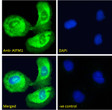| Post Translational Modifications | Under normal conditions, a 54-residue N-terminal segment is first proteolytically removed during or just after translocation into the mitochondrial intermembrane space (IMS) by the mitochondrial processing peptidase (MPP) to form the inner-membrane-anchored mature form (AIFmit). During apoptosis, it is further proteolytically processed at amino-acid position 101 leading to the generation of the mature form, which is confined to the mitochondrial IMS in a soluble form (AIFsol). AIFsol is released to the cytoplasm in response to specific death signals, and translocated to the nucleus, where it induces nuclear apoptosis in a caspase-independent manner. Ubiquitination by XIAP/BIRC4 does not lead to proteasomal degradation. Ubiquitination at Lys-255 by XIAP/BIRC4 blocks its ability to bind DNA and induce chromatin degradation, thereby inhibiting its ability to induce cell death. |
| Function | Functions both as NADH oxidoreductase and as regulator of apoptosis. In response to apoptotic stimuli, it is released from the mitochondrion intermembrane space into the cytosol and to the nucleus, where it functions as a proapoptotic factor in a caspase-independent pathway. Release into the cytoplasm is mediated upon binding to poly-ADP-ribose chains. The soluble form (AIFsol) found in the nucleus induces 'parthanatos' i.e. caspase-independent fragmentation of chromosomal DNA. Binds to DNA in a sequence-independent manner. Interacts with EIF3G, and thereby inhibits the EIF3 machinery and protein synthesis, and activates caspase-7 to amplify apoptosis. Plays a critical role in caspase-independent, pyknotic cell death in hydrogen peroxide-exposed cells. In contrast, participates in normal mitochondrial metabolism. Plays an important role in the regulation of respiratory chain biogenesis by interacting with CHCHD4 and controlling CHCHD4 mitochondrial import. Isoform 4: Has NADH oxidoreductase activity. Does not induce nuclear apoptosis. Isoform 5: Pro-apoptotic isoform. |
| Protein Name | Apoptosis-Inducing Factor 1 - MitochondrialProgrammed Cell Death Protein 8 |
| Cellular Localisation | Mitochondrion Intermembrane SpaceMitochondrion Inner MembraneCytoplasmNucleusPerinuclear RegionProteolytic Cleavage During Or Just After Translocation Into The Mitochondrial Intermembrane Space (Ims) Results In The Formation Of An Inner-Membrane-Anchored Mature Form (Aifmit)During ApoptosisFurther Proteolytic Processing Leads To A Mature FormWhich Is Confined To The Mitochondrial Ims In A Soluble Form (Aifsol)Aifsol Is Released To The Cytoplasm In Response To Specific Death SignalsAnd Translocated To The NucleusWhere It Induces Nuclear ApoptosisRelease Into The Cytoplasm Is Mediated Upon Binding To Poly-Adp-Ribose ChainsTranslocation Into The Nucleus Is Promoted By Interaction With (Auto-Poly-Adp-Ribosylated) Processed Form Of Parp1Colocalizes With Eif3g In The Nucleus And Perinuclear RegionIsoform 3: Mitochondrion Intermembrane SpaceHas A Stronger Membrane Anchorage Than Isoform 1Isoform 4: MitochondrionCytosolIn Pro-Apoptotic ConditionsIs Released From Mitochondria To Cytosol In A Calpain/Cathepsin-Dependent MannerIsoform 5: Cytoplasm |
| Alternative Antibody Names | Anti-Apoptosis-Inducing Factor 1 - Mitochondrial antibodyAnti-Programmed Cell Death Protein 8 antibodyAnti-AIFM1 antibodyAnti-AIF antibodyAnti-PDCD8 antibody |
Information sourced from Uniprot.org














